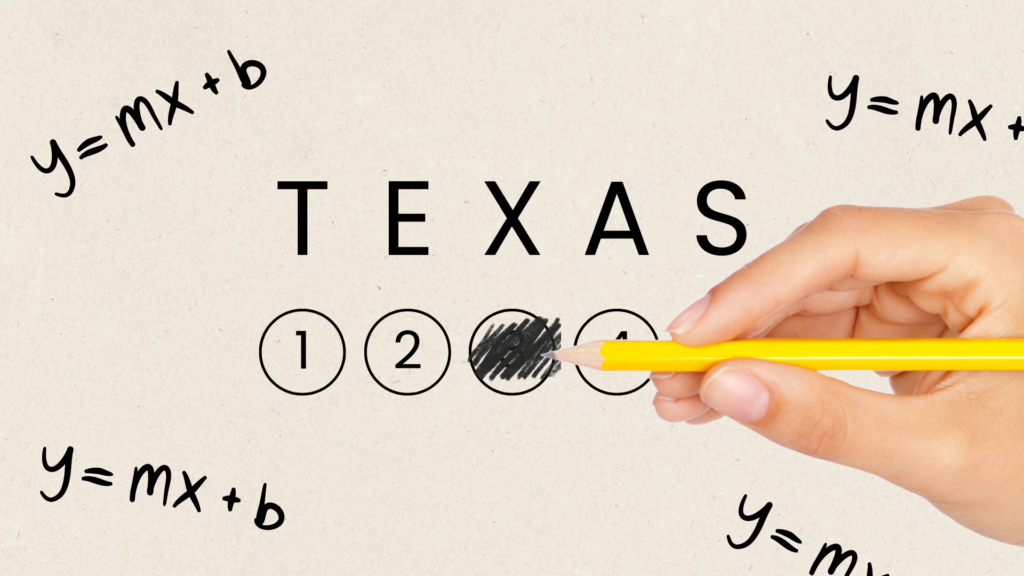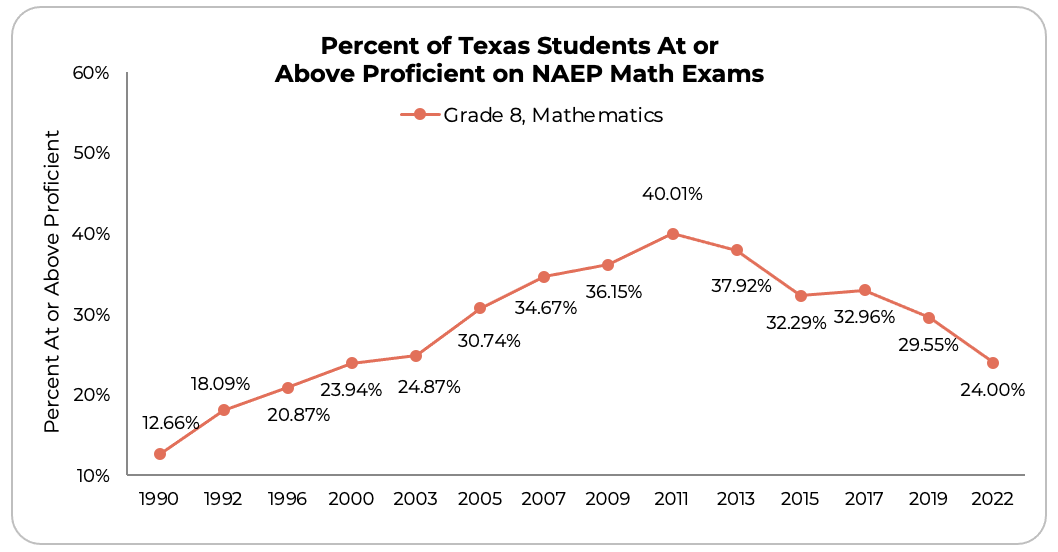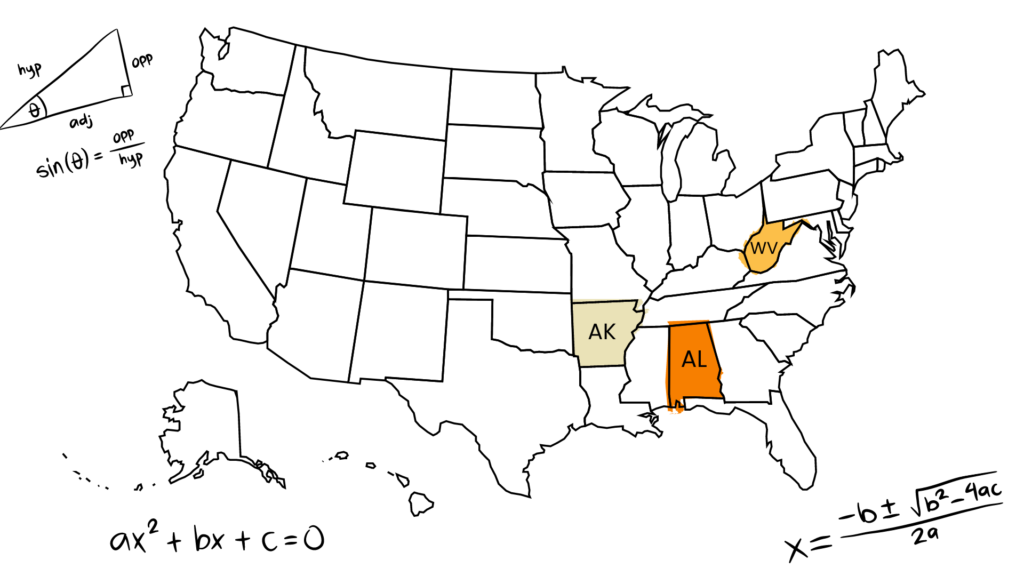New report documents Texas’ growing math problem
This is a preview of our Texas 2036 newsletter taking a look at diagnosing and discussing potential remedies to Texas’ math problem. To receive this weekly look at our work, sign up here.
Solving Texas’ Math Problem

As Texas students reach week two of STAAR testing, Texas 2036 reviewed the data in its latest report, “Solving for X”, on the state of math in Texas, and how students do not have the level of math proficiency needed to be successful in today’s — or tomorrow’s — economy.
To find a solution, we looked at multiple data sources and gathered lessons from at home and other states to see what steps Texas has taken to address a significant decline.
 “The ability of Texas to lead and attract top industries hinges on equipping our workforce with essential STEM skills. Math skills are essential to college success, and to realizing the aspirations students have in a wide variety of endeavors.”
“The ability of Texas to lead and attract top industries hinges on equipping our workforce with essential STEM skills. Math skills are essential to college success, and to realizing the aspirations students have in a wide variety of endeavors.”
– Incoming President and CEO David Leebron
What does the data tell us?

Texas students are not demonstrating the level of math achievement needed to be successful in today’s — or tomorrow’s — economy.
- 55% of Texas students are below grade level in math, but only one in 10 parents believe their child is performing below grade level in math.
- A 21-point decline has been recorded in the percentage of Texas eighth grade students at or above Basic in math since 2011.
- Texas eighth graders dropped roughly two grade levels in data analysis, statistics and probability skills since 2011.
- In nearly every grade, Texas students remain below pre-pandemic math achievement.
- Less than half of Texas high school graduates meet college readiness benchmarks in math.
Texas’ math problem is not new.

Texas’ problem with math started long before the COVID-19 pandemic caused unprecedented disruptions to learning.
The percentage of eighth graders testing at or above Proficient on the NAEP Math exam peaked at 40% in 2011, tumbling significantly since then. In 2022, less than one-fourth of Texas eighth graders tested Proficient in math.
 “No matter which data you examine, the same troubling trend emerges, Texas has a problem with math proficiency. The challenge isn’t new and has been worsening long before the pandemic.”
“No matter which data you examine, the same troubling trend emerges, Texas has a problem with math proficiency. The challenge isn’t new and has been worsening long before the pandemic.”
– Education Policy Advisor Gabe Grantham
This is a problem Texas can solve.

While policymakers contemplate ways to improve math education in Texas, it is worth considering options that take a comprehensive approach incorporating students, teachers and parents to help students succeed, such as:
- Supporting high-quality math instruction.
- Producing high-quality professional development and coaching to ensure teachers are equipped with tools to help struggling students.
- Increasing the emphasis placed on math content and pedagogy in Educator Preparation Programs.
- Utilizing math “screeners” — short diagnostics that identify who is struggling and what types of support they need to progress toward grade-level goals — in early grades and promptly notifying parents of identified difficulties.
- Providing parents with resources to support tailored “math-at-home” instruction.
- Developing targeted plans for children in need of math intervention, including activities during the summer
- Measuring math achievement in high school grades to increase visibility.
Learning from other states
Texas has adopted promising reforms in recent years, and state leaders can learn from efforts undertaken in other states as they continue to take bold steps to ensure Texas students can succeed in the modern economy.

Alabama: Passed the 2022 numeracy act, which invested heavily in math coaching in elementary school with the goal of having a math coach in every K-5 campus by school year 2027-28.
Arkansas: Requires that each parent receive notice when their child is enrolled in a math improvement plan and be updated on their child’s progress.
West Virginia: Requires the state board to develop an “appropriate list of literacy and numeracy screening tools” that are required to be administered to K-3 students. They must be given in the first 30 days of the school year and then repeated at mid-year and end-of-year.
Texas vs. California: Rival Approaches to Improving Advanced Math Access and Equity

In 2023, the Texas Legislature passed Senate Bill 2124, which will enroll all qualified students in Algebra 1. Taking an opposite approach, the California State Board of Education suggests delaying access to advanced math for most students in an attempt to promote equity. How these two states address shared challenges — and the divergent approaches they pursue — may shape the nation’s future growth.
While Texas is enrolling more middle school students in Algebra 1, California’s State Board of Education adopted guidance that questions the need for offering this critical course before high school.
California’s efforts to delay enrollment in Algebra 1 until high school were met with objections from both experts and parents concerned that this proposed direction “would hold back students who were ready for more advanced math, putting them at a disadvantage in applying for college with students from other states.”
Meanwhile, in Texas, school districts like Dallas ISD (DISD) have previously implemented policies similar to SB 2124 and have seen enrollment in advanced math courses better reflect the diversity of the district. After implementing the policy that informed Senate Bill 2124, DISD saw the percentage of those enrolled in advanced math increase across multiple student groups. The percentage of Black students enrolling in sixth grade honors math more than doubled, rising from 17% to 43%. Among Hispanic and white students, there were increases of 26 and 31 percentage points, respectively.
Do you use math in your everyday life?
Let us know in our short survey!
